Use of Waste Tires as Transverse Reinforcement and External Confinement in Concrete Columns Subjected to Axial Loads
Abstract
:1. Introduction
1.1. Literature Review
- fyh is the yield stress of the confining spirals, MPa
- Ssp is the pitch of the confining spirals, mm
- ds is the diameter of spirals between bar centers, mm.
1.2. Problem Statement
2. Experimental Works
2.1. Material and Specimens Specification
2.2. Construction
2.3. Instrumentation and Test Setup
2.4. Experimental Results
- (a)
- Two unconfined columns with normal concrete (UCNCs),
- (b)
- Two unconfined columns with rubberized concrete (UCRCs),
- (c)
- Two confined columns with normal concrete (CCNCs),
- (d)
- Two confined columns with rubberized concrete (CCRCs),
- (e)
- Two confined columns with normal concrete with tires cut along the height (CCNCHs),
- (f)
- Two confined columns with rubberized concrete with tires cut along the height (CCRCHs).
2.4.1. Unconfined Concrete Column: Normal Concrete vs. Rubberized Concrete
2.4.2. Confined Concrete Column: Normal Concrete vs. Rubberized Concrete
2.4.3. Confined Concrete Columns with Tires Cut along the Height: Normal Concrete vs. Rubberized Concrete
2.4.4. Normal Concrete Columns Comparison
2.4.5. Rubberized Concrete Columns Comparison
2.5. Tire Confinement Effect
- At is the cross-sectional area of the tire at the threaded wall, mm2
- D is the inside diameter of the column, mm
- Ssp is the pitch between the tires, mm.
3. Discussion
- Cyclical loading of tire columns using displacement-controlled testing methods to understand the confinement properties provided by tires fully.
- Rubber-concrete contact relationship with the tire aging.
- Testing the physical properties of waste tires to understand their wear and tear.
- Testing single tires filled with concrete to quantify the confinement of the tire.
- Testing tire columns and benchmark unconfined columns with the same dimensions.
- Testing tire columns with and without reinforcing rebar under flexure loading.
4. Conclusions
- (a)
- Shear and columnar failure were common failure modes in unconfined normal concrete and rubber concrete specimens.
- (b)
- In the case of rubber concrete, only the unconfined specimens exhibited a higher total energy dissipation under monotonic compression loading compared to normal concrete specimens. This variation in energy dissipation could be attributed to tire variations and their respective wear and tear.
- (c)
- The confined columns, whether made of normal or rubber concrete, achieved a higher concrete axial force before failure than the unconfined columns.
- (d)
- After concrete failure, confined normal concrete and rubber concrete columns displayed strain-softening behavior. However, the columns continued to pick up force after the drop but never reached the previous peak force.
- (e)
- Confined concrete columns with tires cut along their height exhibited a significantly greater reduction in force after concrete failure compared to confined concrete columns without such cuts.
- (f)
- Among columns with normal concrete, the highest energy dissipation under monotonic compression loading was observed in CCNCs, followed by CCNCHs and UCNCs.
- (g)
- Among columns with rubber concrete, the greatest energy dissipation under monotonic compression loading was observed in CCRCs, followed by CCRCHs and UCRCs.
Author Contributions
Funding
Institutional Review Board Statement
Informed Consent Statement
Data Availability Statement
Acknowledgments
Conflicts of Interest
References
- Gagg, C.R. Cement and concrete as an engineering material: An historic appraisal and case study analysis. Eng. Fail. Anal. 2014, 40, 114–140. [Google Scholar] [CrossRef]
- Chen, M.; Si, H.; Fan, X.; Xuan, Y.; Zhang, M. Dynamic compressive behaviour of recycled tyre steel fibre reinforced concrete. Constr. Build. Mater. 2022, 316, 125896. [Google Scholar] [CrossRef]
- Siddique, R.; Naik, T.R. Properties of concrete containing scrap-tire rubber–an overview. Waste Manag. 2004, 24, 563–569. [Google Scholar] [CrossRef]
- Formela, K. Sustainable development of waste tires recycling technologies–recent advances, challenges and future trends. Adv. Ind. Eng. Polym. Res. 2021, 4, 209–222. [Google Scholar]
- Ahmad, I.; Iqbal, M.; Abbas, A.; Badrashi, Y.I.; Jamal, A.; Ullah, S.; Yosri, A.M.; Hamad, M. Enhancement of Confinement in Scaled RC Columns using Steel Fibers Extracted from Scrap Tyres. Materials 2022, 15, 3219. [Google Scholar] [CrossRef]
- Wang, J.; Dai, Q.; Si, R.; Guo, S. Mechanical, durability, and microstructural properties of macro synthetic polypropylene (PP) fiber-reinforced rubber concrete. J. Clean. Prod. 2019, 234, 1351–1364. [Google Scholar] [CrossRef]
- Halsband-Lenk, C.; Sørensen, L.; Booth, A.; Herzke, D. Car tire crumb rubber: Does leaching produce a toxic chemical cocktail in coastal marine systems? Front. Environ. Sci. 2020, 8, 125. [Google Scholar] [CrossRef]
- Sitepu, M.H.; Matondang, A.R.; Sembiring, M.T. Used tires recycle management and processing: A review. In Proceedings of the IOP Conference Series: Materials Science and Engineering. IOP Publ. 2020, 801, 012116. [Google Scholar]
- European Tire and Rubber Manufacturers Association. ETRMA. Europe—91% of All End of Life Tyres Collected and Treated in 2018. Brussels, Belgium. Available online: https://www.etrma.org/library/europe-91-of-all-end-of-life-tyres-collected-and-treated-in-2018/ (accessed on 24 July 2022).
- Huang, W. Sustainable management of different systems for recycling end-of-life tyres in China. Waste Manag. Res. 2021, 39, 966–974. [Google Scholar] [CrossRef]
- Dabiri, H.; Kheyroddin, A. An analytical study into the seismic behavior of RC pier with elastomeric materials. Asian J. Civ. Eng. (Bhrc) 2017, 18, 1183–1193. [Google Scholar]
- Jia, J.; Zhang, K.; Saiidi, M.S.; Guo, Y.; Wu, S.; Bi, K.; Du, X. Seismic evaluation of precast bridge columns with built-in elastomeric pads. Soil Dyn. Earthq. Eng. 2020, 128, 105868. [Google Scholar]
- Pitilakis, K.; Karapetrou, S.; Tsagdi, K. Numerical investigation of the seismic response of RC buildings on soil replaced with rubber–sand mixtures. Soil Dyn. Earthq. Eng. 2015, 79, 237–252. [Google Scholar] [CrossRef]
- Oikonomou, N.; Mavridou, S. The use of waste tyre rubber in civil engineering works. In Sustainability of Construction Materials; Elsevier: Amsterdam, The Netherlands, 2009; pp. 213–238. [Google Scholar]
- Strukar, K.; Šipoš, T.K.; Miličević, I.; Bušić, R. Potential use of rubber as aggregate in structural reinforced concrete element—A review. Eng. Struct. 2019, 188, 452–468. [Google Scholar] [CrossRef]
- Venu, M.; Rao, P. Study of rubber aggregates in concrete: An experimental investigation. Int. J. Civ. Eng. Technol. 2010, 1, 15–26. [Google Scholar]
- Siddiqui, M.M.A. Study of rubber aggregates in concrete an experimental investigation. Int. J. Latest Res. Eng. Technol. 2016, 2, 36–57. [Google Scholar]
- Batayneh, M.; Marie, I.; Asi, I. Use of selected waste materials in concrete mixes. Waste Manag. 2007, 27, 1870–1876. [Google Scholar] [CrossRef] [PubMed]
- Liu, L.; Cai, G.; Liu, S. Compression properties and micro-mechanisms of rubber-sand particle mixtures considering grain breakage. Constr. Build. Mater. 2018, 187, 1061–1072. [Google Scholar] [CrossRef]
- Batayneh, M.K.; Marie, I.; Asi, I. Promoting the Use of Crumb Rubber Concrete in Developing Countries. Waste Manag. 2008, 28, 2171–2176. [Google Scholar] [CrossRef]
- Güneyisi, E.; Gesoğlu, M.; Özturan, T. Properties of rubberized concretes containing silica fume. Cem. Concr. Res. 2004, 34, 2309–2317. [Google Scholar] [CrossRef]
- Razvi, S.W.N.; Shaikh, M. Effect of confinement on behavior of short concrete column. Procedia Manuf. 2018, 20, 563–570. [Google Scholar] [CrossRef]
- Pham, T.M.; Hao, H. Confinement efficiency of concrete cylinders wrapped with different types of FRP under impact loads. In Proceedings of the Mechanics of Structures and Materials: Advancements and Challenges-Proceedings of the 24th Australasian Conference on the Mechanics of Structures and Materials, Perth, Australia, 6–9 December 2016; Volume 2017, pp. 515–520. [Google Scholar]
- Wang, W.; Martin, P.R.; Sheikh, M.N.; Hadi, M.N. Eccentrically loaded FRP confined concrete with different wrapping schemes. J. Compos. Constr. 2018, 22, 04018056. [Google Scholar] [CrossRef] [Green Version]
- Abdullah, W.; Omar, A.; Rafiq, S.K. Experimental Work on Using Fully Wrapped Post-Tensioned Metal Straps Around Normal Reinforced Concrete Beams to Increase Flexural Strength of RC Beams. Sulaimania J. Eng. Sci. 2021, 8. [Google Scholar] [CrossRef]
- Garcia, R.; Pilakoutas, K.; Hajirasouliha, I.; Guadagnini, M.; Kyriakides, N.; Ciupala, M.A. Seismic retrofitting of RC buildings using CFRP and post-tensioned metal straps: Shake table tests. Bull. Earthq. Eng. 2017, 15, 3321–3347. [Google Scholar]
- Imjai, T.; Chaisakulkiet, U.; Garcia, R.; Pilakoutas, K. Strengthening of RC members using Post-Tensioned Metal Straps: State of the research. Lowl. Technol. Int. 2018, 20, 109–118. [Google Scholar]
- Ma, C.K.; Garcia, R.; Yung, S.C.S.; Awang, A.Z.; Omar, W.; Pilakoutas, K. Strengthening of pre-damaged concrete cylinders using post-tensioned steel straps. Proc. Inst. Civ. Eng.-Struct. Build. 2019, 172, 703–711. [Google Scholar] [CrossRef]
- Imjai, T.; Setkit, M.; Garcia, R.; Figueiredo, F.P. Strengthening of damaged low strength concrete beams using PTMS or NSM techniques. Case Stud. Constr. Mater. 2020, 13, e00403. [Google Scholar] [CrossRef]
- Rubel, S.N.R.; Rahman, M.; Saju, J. Review Study on Different Concrete Confinement Materials and Mechanisms. In Proceedings of the 2nd International Conference on Research and Innovation in Civil Engineering, Chittagong, Bangladesh, 11 January 2020. [Google Scholar]
- Mander, J.B.; Priestley, M.J.; Park, R. Theoretical stress-strain model for confined concrete. J. Struct. Eng. 1988, 114, 1804–1826. [Google Scholar] [CrossRef] [Green Version]
- De Lorenzis, L.; Tepfers, R. Comparative study of models on confinement of concrete cylinders with fiber-reinforce polymer composites. J. Compos. Constr. 2003, 7, 219–237. [Google Scholar] [CrossRef]
- Teng, J.G.; Chen, J.F.; Smith, S.T.; Lam, L. FRP: Strengthened RC Structures; Wiley: Hoboken, NJ, USA, 2002. [Google Scholar]
- Abdelrahman, K.; El-Hacha, R. Analytical prediction model for circular SMA-confined reinforced concrete columns. Eng. Struct. 2020, 213, 110547. [Google Scholar] [CrossRef]
- U.S Tire Manufacturers Association. WHAT’S IN A TIRE. Washington, DC., USA. Available online: https://www.ustires.org/whats-tire-0 (accessed on 24 July 2022).
- ASTM C31/C31M-22; Standard Practice for Making and Curing Concrete Test Specimens in the Field. ASTM International: West Conshohocken, PA, USA, 2019.
- ASTM C39/C39M-21; Standard Test Method for Compressive Strength of Cylindrical Concrete Specimens. ASTM International: West Conshohocken, PA, USA, 2021.
- Faizah, R.; Priyosulistyo, H.; Aminullah, A. The Properties of Waste Rubber Tires in Increasing the Damping of Masonry Wall Structure. In Proceedings of the IOP Conference Series: Materials Science and Engineering. IOP Publ. 2019, 650, 012041. [Google Scholar]
- Bijarimi, M.; Zulkafli, H.; Beg, M.D.H. Mechanical properties of industrial tyre rubber compounds. J. Appl. Sci. (Faisalabad) 2010, 10, 1345–1348. [Google Scholar] [CrossRef] [Green Version]

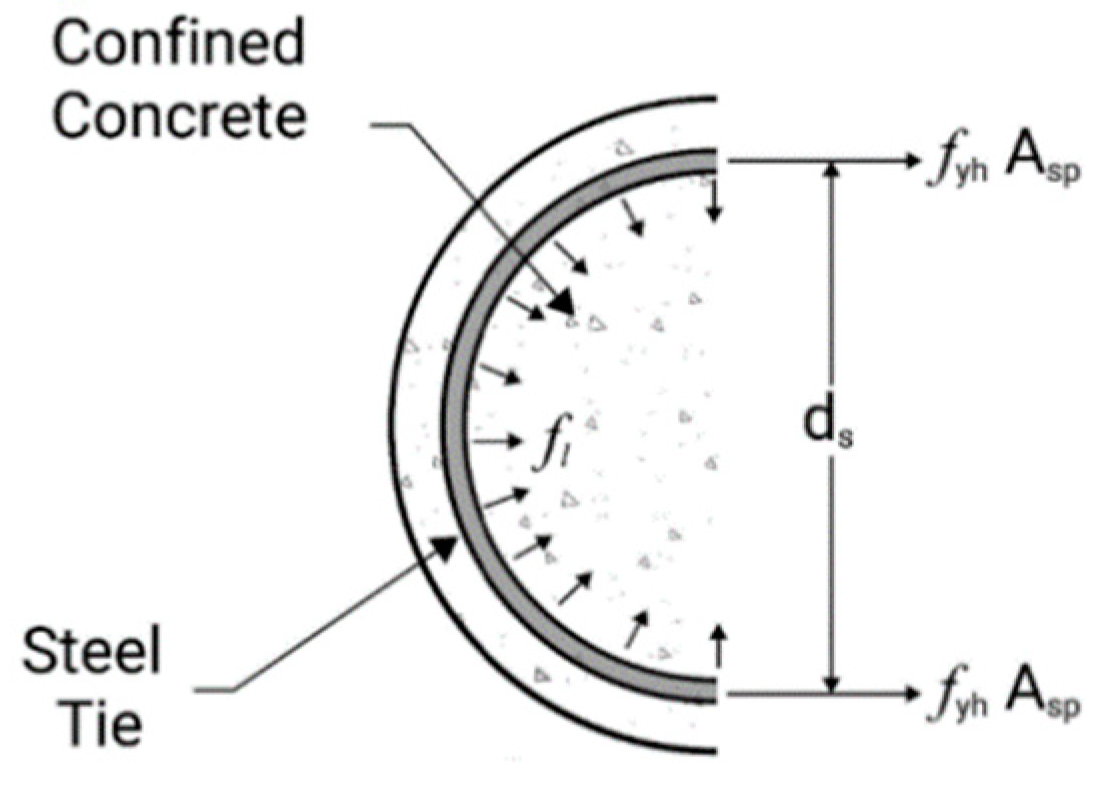

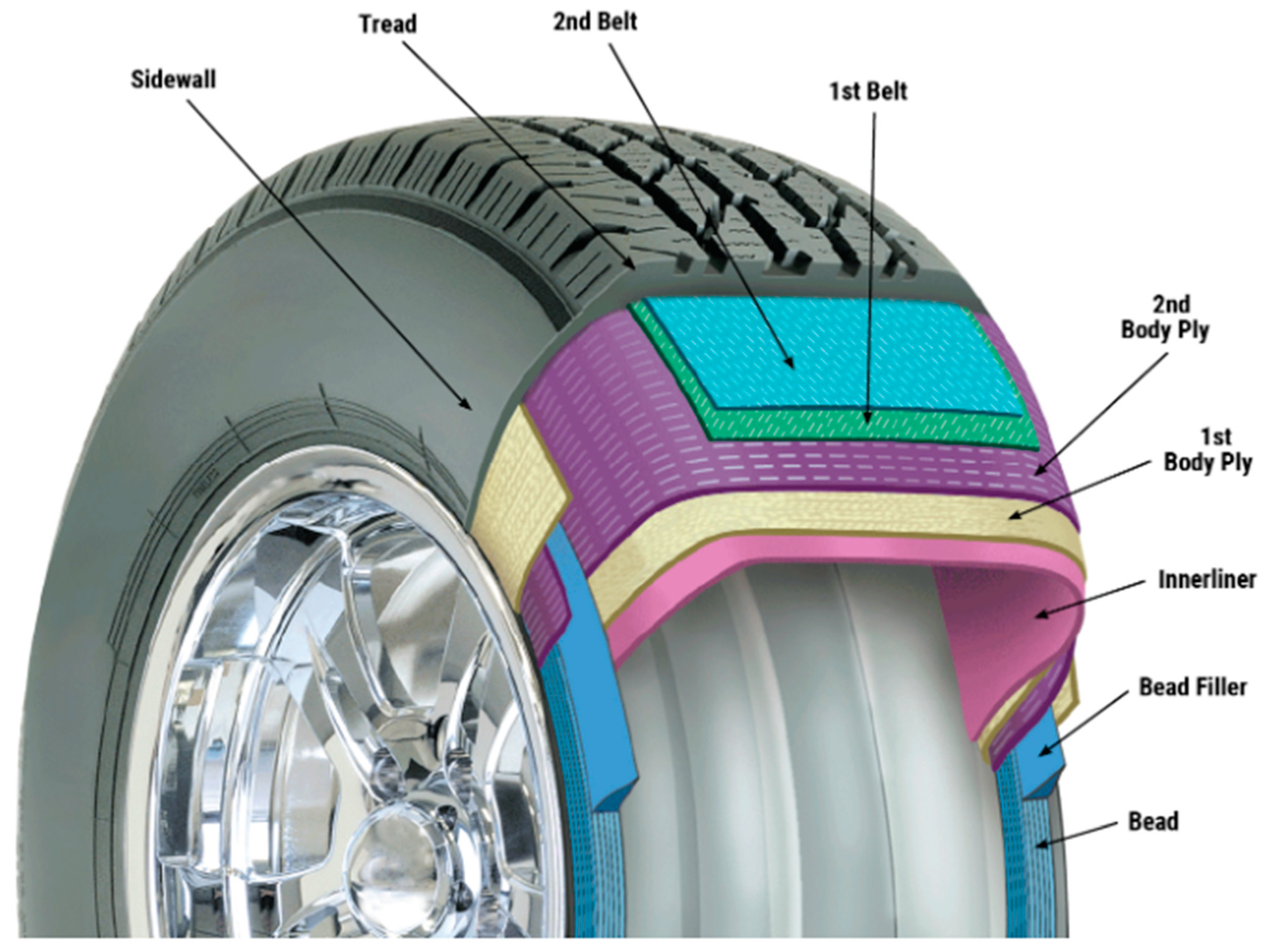
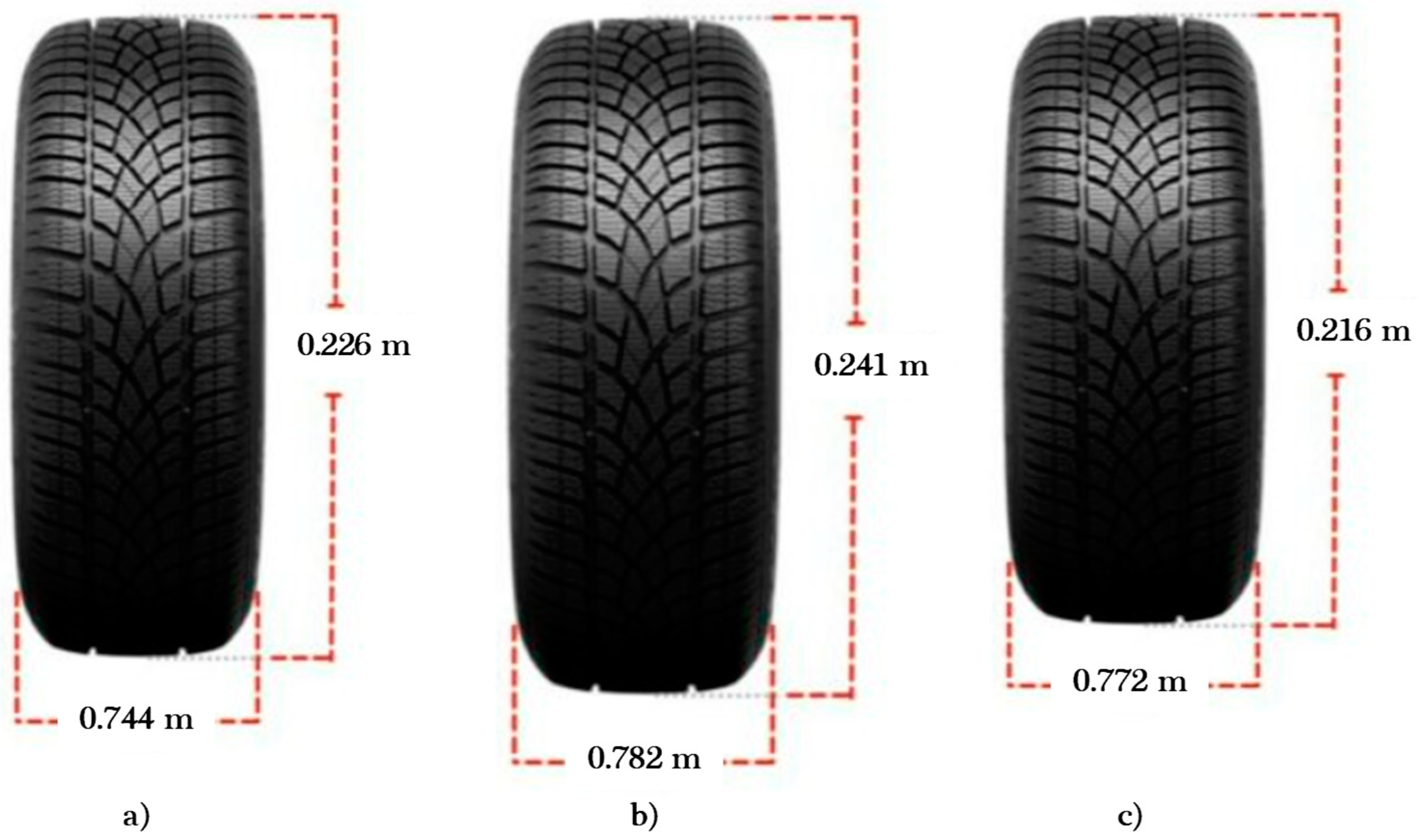
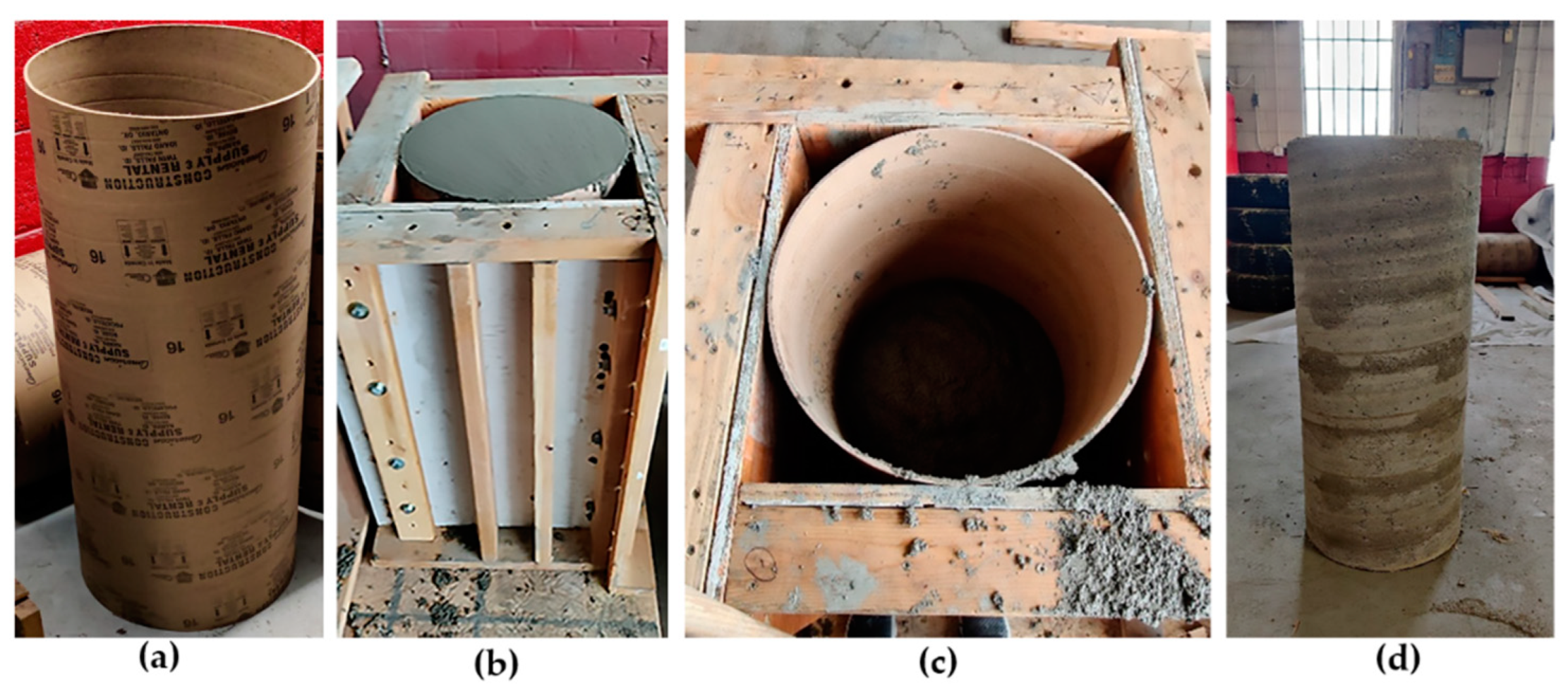

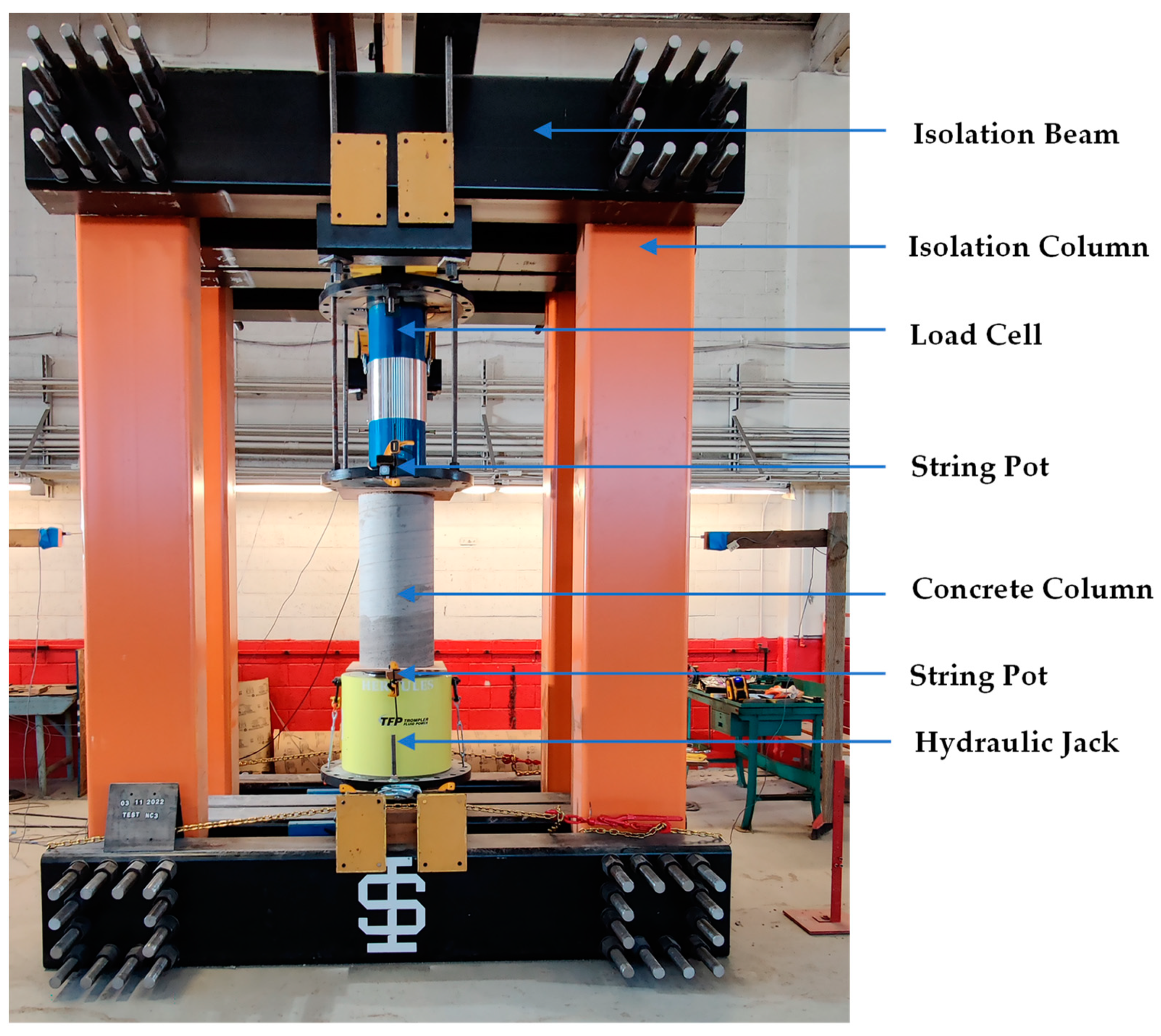


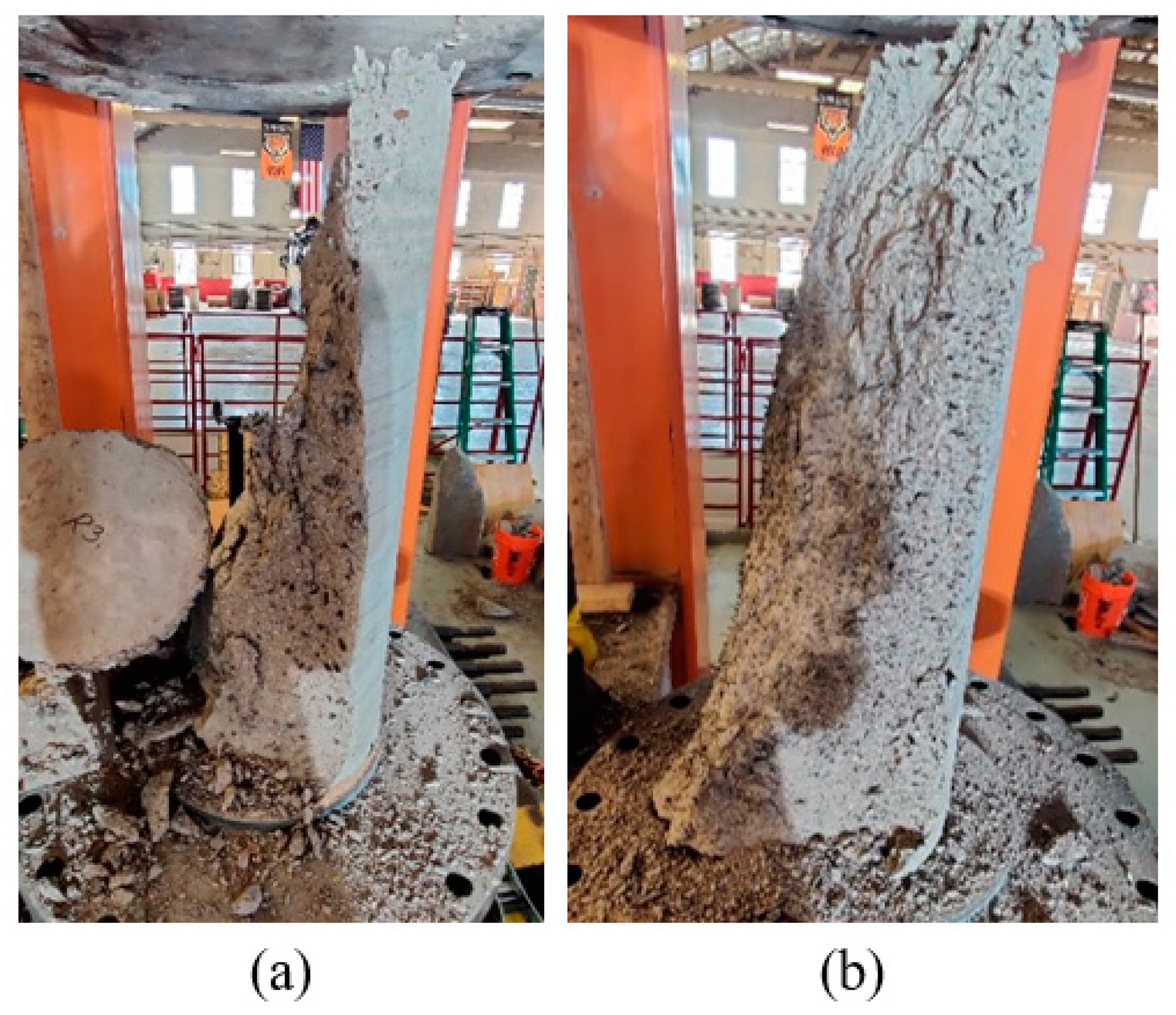




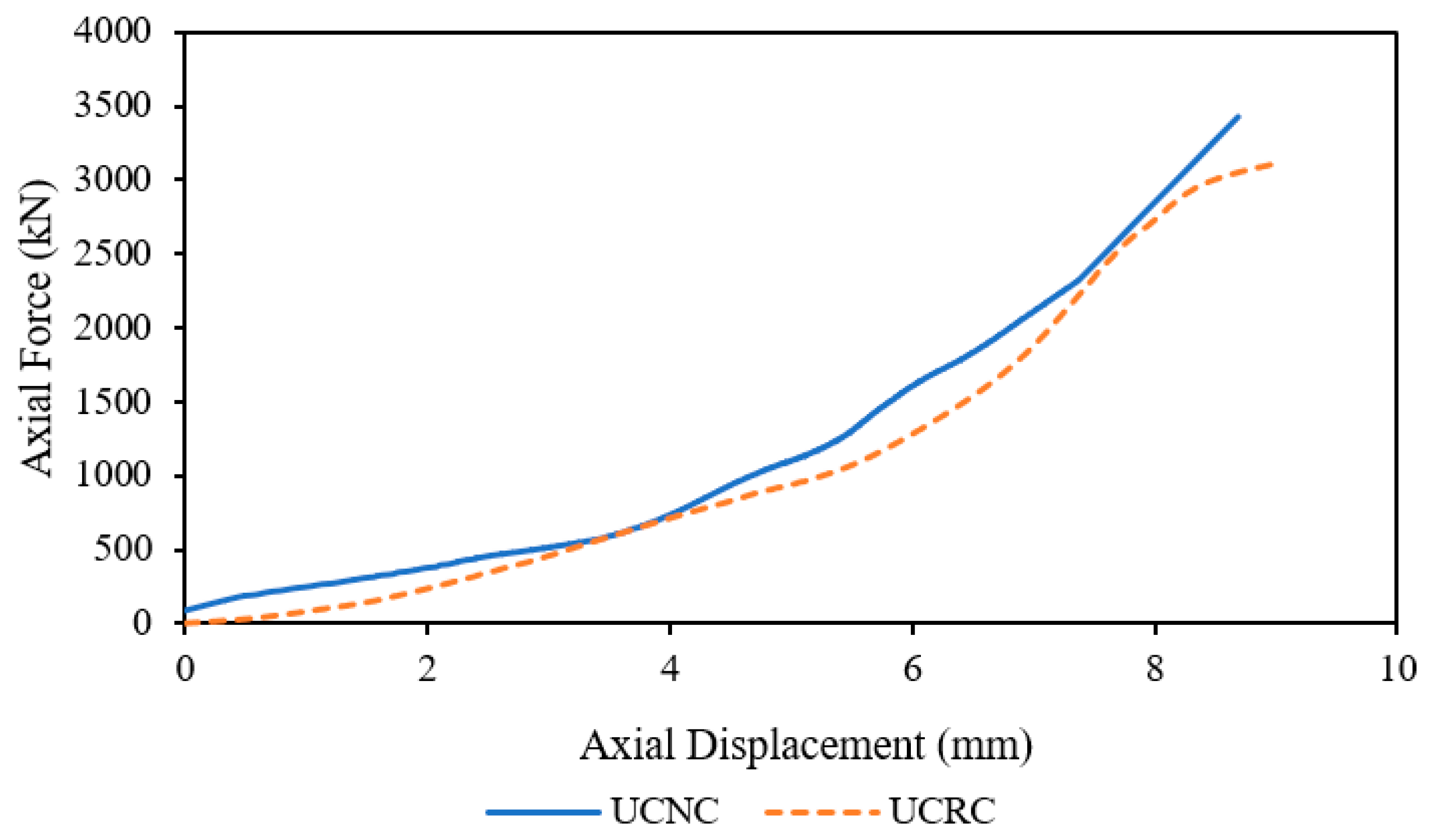
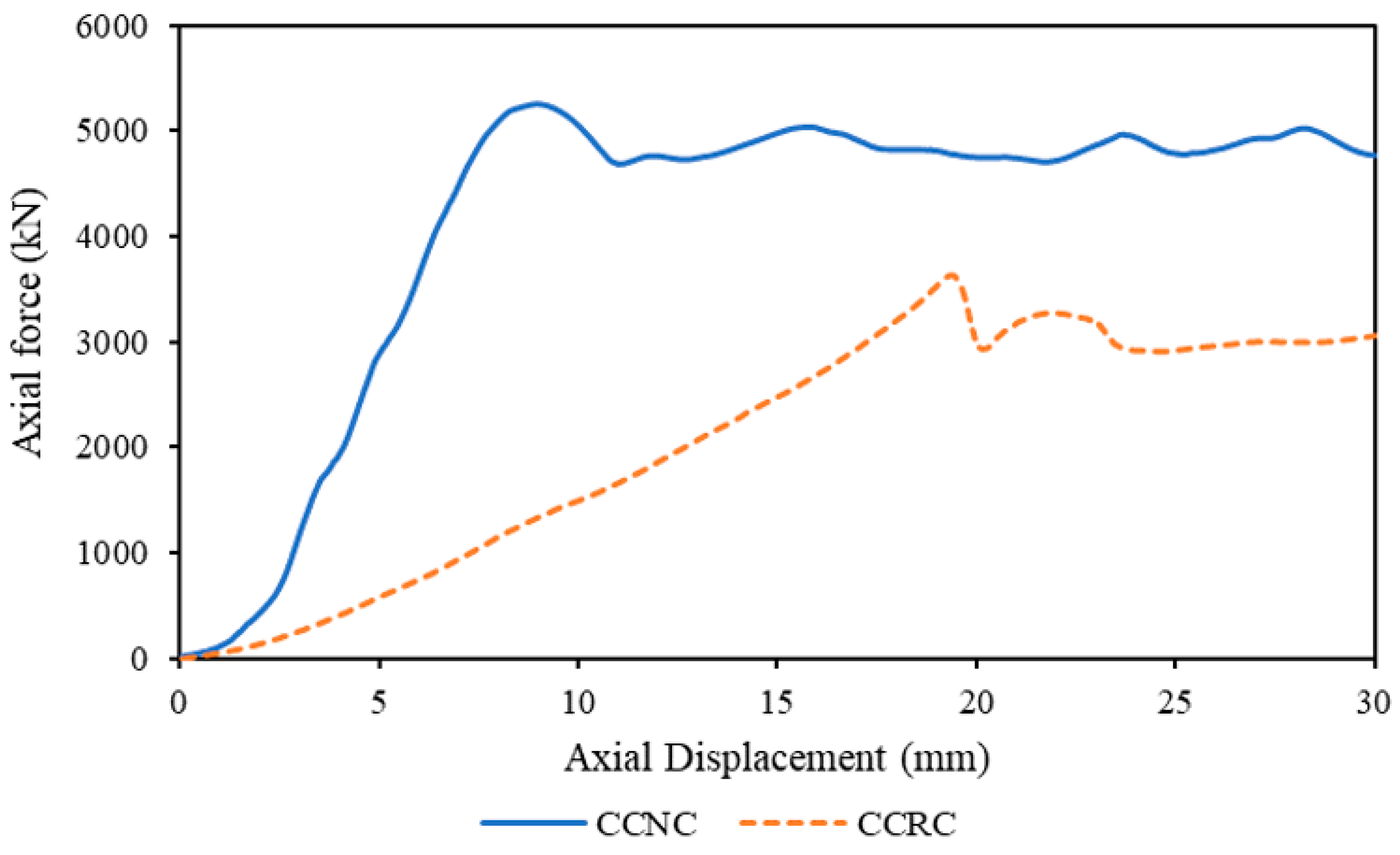
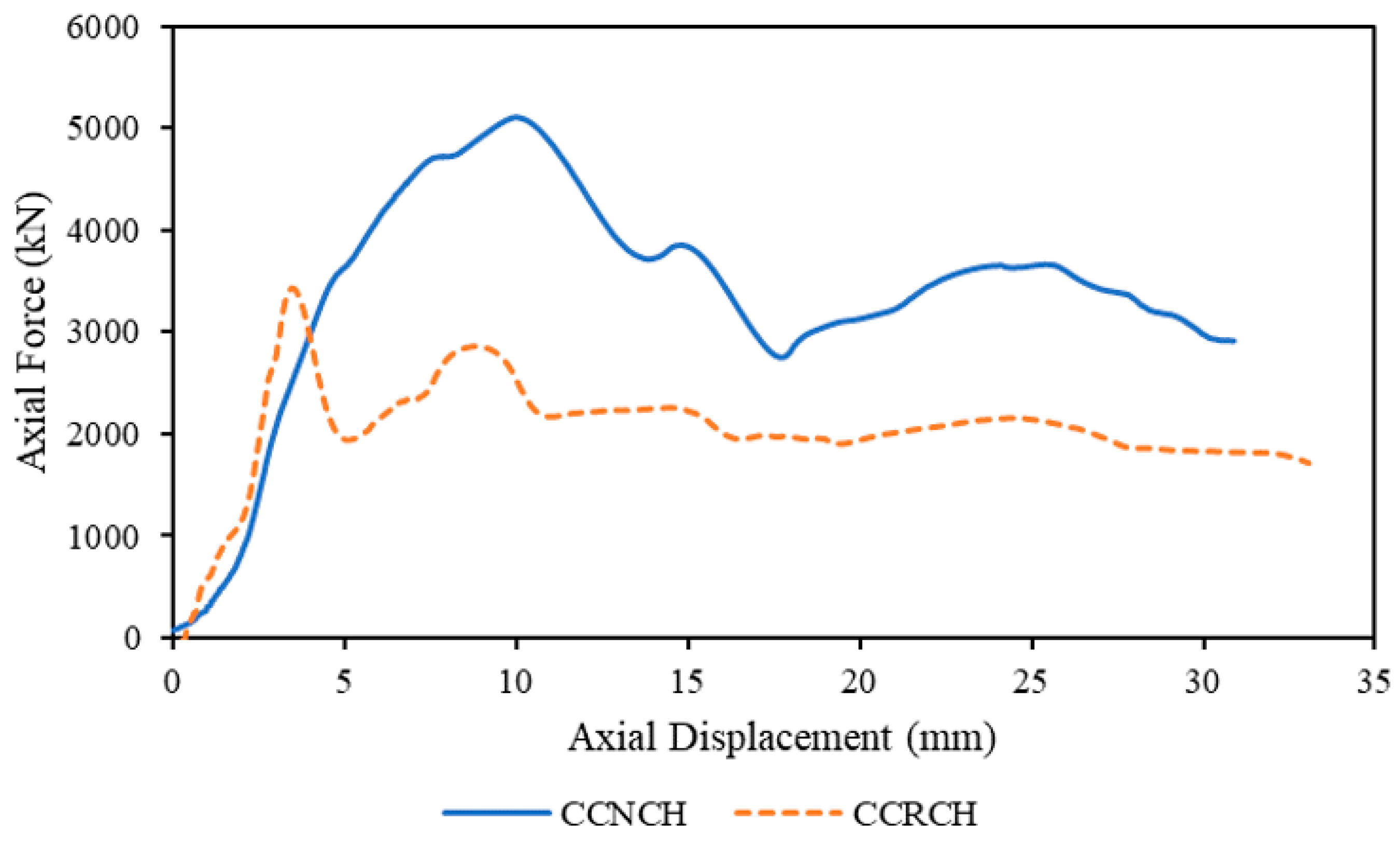
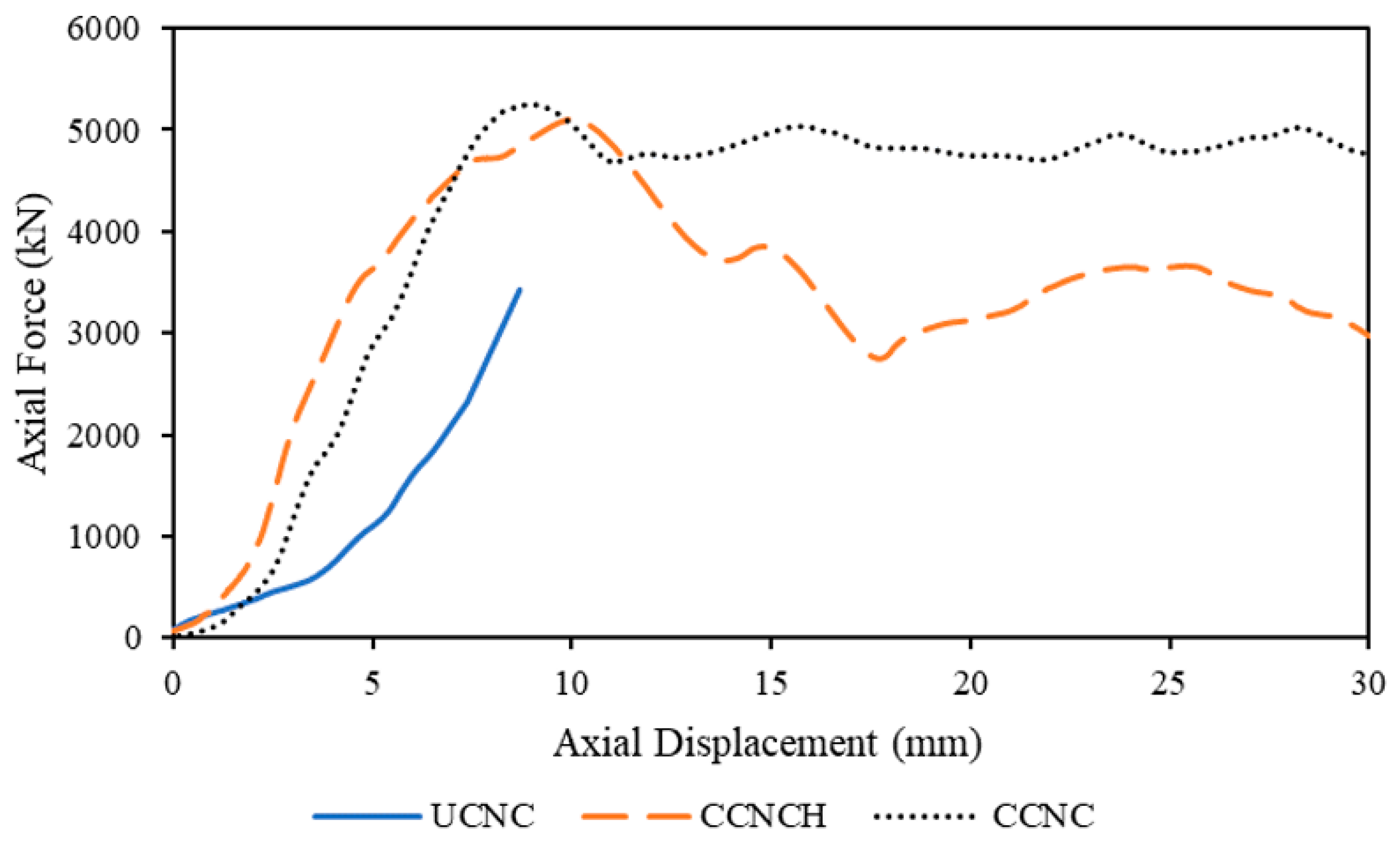
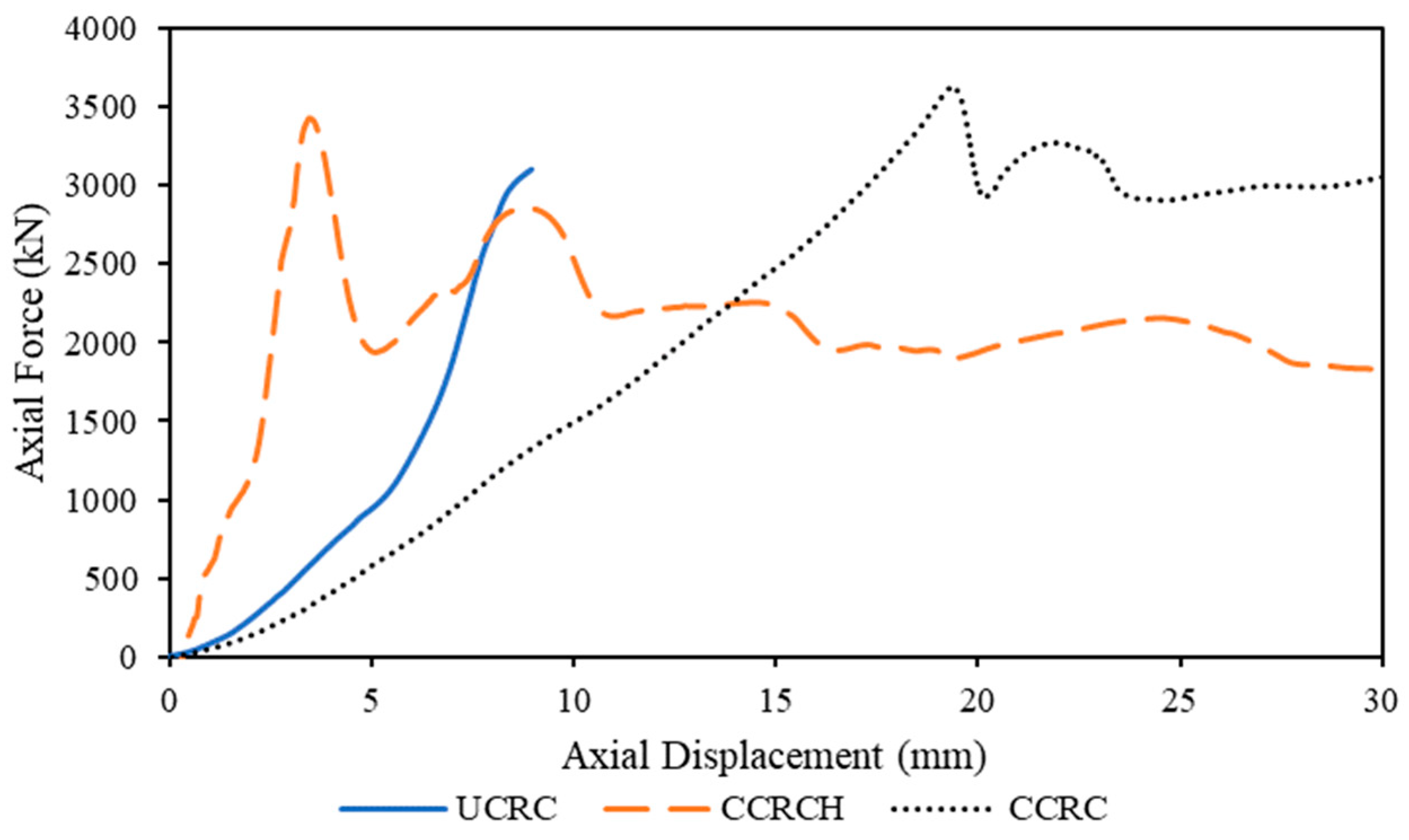

| Normal Concrete | Rubberized Concrete | ||
|---|---|---|---|
| Material | Weight (kg/cu.m) | Material | Weight (kg/cu.m) |
| Cement | 352.4 | Cement | 520.6 |
| Fly Ash | 296.9 | Fly Ash | 130.4 |
| Fine Aggregate | 1210.9 | Fine Aggregate | 1210.9 |
| Coarse Aggregate | 576.7 | Coarse Aggregate | 490.2 |
| Water | 267.5 | Rubber Aggregate | 29.0 |
| Water | 267.5 | ||
| Specimen | Average Compressive Strength (MPa) |
|---|---|
| Unconfined Normal Concrete | 35.2 |
| Confined Normal Concrete | 34.8 |
| Confined Rubberized Concrete | 35.1 |
| Unconfined Rubberized Concrete | 34.9 |
| Type: Unconfined | Maximum Axial Force (kN) | Corresponding Displacement (mm) | Maximum Stress (MPa) | Strain (mm/mm) | Energy Dissipation (kJ) |
|---|---|---|---|---|---|
| UCNC1 | 3426.9 | 5.99 | 26.4 | 0.00654 | 7.99 |
| UCNC2 | 2783.9 | 10.13 | 21.4 | 0.00811 | 9.15 |
| UCRC1 | 3258.5 | 9.96 | 25.1 | 0.01089 | 11.75 |
| UCRC2 | 2998.7 | 8.89 | 23.1 | 0.00965 | 10.53 |
| CCNC1 | 6031.7 | 10.1 | 46.5 | 0.01109 | 94.18 |
| CCNC2 | 5093.2 | 11.4 | 39.2 | 0.01259 | 46.77 |
| CCRC1 | 3567.0 | 9.1 | 27.5 | 0.00990 | 12.68 |
| CCRC2 | 4317.8 | 30.2 | 33.3 | 0.03323 | 62.10 |
| CCNCH1 | 4948.2 | 10.7 | 38.1 | 0.01177 | 47.03 |
| CCNCH2 | 5412.2 | 9.9 | 41.7 | 0.01095 | 55.29 |
| CCRCH1 | 4752.4 | 2.4 | 36.6 | 0.00259 | 9.59 |
| CCRCH2 | 3714.7 | 7.9 | 28.6 | 0.00870 | 23.75 |
| Type | Average Maximum Compressive Stress (f′cc) MPa | Average Confinement Effectiveness, kl (f′cc/f′co) |
|---|---|---|
| CCNC | 42.8 | 1.78 |
| CCRC | 30.4 | 1.26 |
| CCNCH | 39.9 | 1.67 |
| CCRCH | 36.6 | 1.35 |
| Tire | Inner Diameter (mm) | Threaded Section Width (mm) | Confining Pressure, fl (MPa) |
|---|---|---|---|
| 225/75R16 | 712.5 | 200.7 | 2.24 |
| 235/80R16 | 750.6 | 210.8 | 2.24 |
| 215/85R16 | 740.4 | 190.5 | 2.05 |
| Type | Specimen | Actual Confinement (fl/f′co) |
|---|---|---|
| CCNC | CCNC1 | 0.094092 |
| CCNC2 | 0.094092 | |
| CCRC | CCRC1 | 0.093553 |
| CCRC2 | 0.093553 | |
| CCNCH | CCNCH1 | 0.094092 |
| CCNCH2 | 0.094092 | |
| CCRCH | CCRCH1 | 0.093553 |
| CCRCH2 | 0.093553 |
Disclaimer/Publisher’s Note: The statements, opinions and data contained in all publications are solely those of the individual author(s) and contributor(s) and not of MDPI and/or the editor(s). MDPI and/or the editor(s) disclaim responsibility for any injury to people or property resulting from any ideas, methods, instructions or products referred to in the content. |
© 2023 by the authors. Licensee MDPI, Basel, Switzerland. This article is an open access article distributed under the terms and conditions of the Creative Commons Attribution (CC BY) license (https://creativecommons.org/licenses/by/4.0/).
Share and Cite
Mahat, M.; Acharya, M.; Acharya, M.; Mashal, M. Use of Waste Tires as Transverse Reinforcement and External Confinement in Concrete Columns Subjected to Axial Loads. Sustainability 2023, 15, 11620. https://doi.org/10.3390/su151511620
Mahat M, Acharya M, Acharya M, Mashal M. Use of Waste Tires as Transverse Reinforcement and External Confinement in Concrete Columns Subjected to Axial Loads. Sustainability. 2023; 15(15):11620. https://doi.org/10.3390/su151511620
Chicago/Turabian StyleMahat, Mahesh, Mahesh Acharya, Manish Acharya, and Mustafa Mashal. 2023. "Use of Waste Tires as Transverse Reinforcement and External Confinement in Concrete Columns Subjected to Axial Loads" Sustainability 15, no. 15: 11620. https://doi.org/10.3390/su151511620







